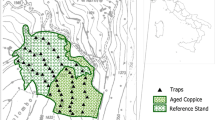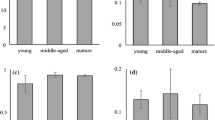Abstract
Predator–prey dynamics regulate the community structure of arthropods and may be affected by changes in their habitat. Bottom-up effects influence the distribution of arboreal insects changing, in turn, the availability of resources and shelter for the spider assemblage. This study examines the effect of habitat structure (tree richness and density) on the assemblages of herbivorous insects and spiders along a gradient of secondary forest succession in a semiarid Caatinga in northeastern Brazil. Insect and spiders were collected by beating the foliage during dry and wet seasons in 2010 and 2011. Plant richness and density varied significantly among stages of succession. In total, 2,590 arboreal insects were collected, corresponding to 14 orders and 151 morphospecies. In addition, we sampled 896 canopy spiders, encompassing 14 families and 53 morphospecies. Insect richness and abundance were negatively related with habitat structure, while spider richness increases with tree richness. We did not find any relationship among insects and spiders but there were differences in species composition of insects among all successional stages, determined by changes in vegetation structure. However, this effect does not extend to the species composition of spiders that remain similar in the different stages of secondary succession. We conclude that habitat structure had a partial bottom-up effect on arboreal insects and spider assemblages, indicating that this factor regulates the richness, abundance and species composition of arboreal insets and species richness of spiders. Thus, habitat structure promotes the maintenance of insects and spider diversity in fragments of Caatinga.



Similar content being viewed by others
References
Anderson MJ (2001) A new method for non-parametric multivariate analysis of variance. Austral Ecol 26:32–46
Andow DA (1991) Vegetational diversity and arthropod population response. Annu Rev Ecol Syst 22:561–586
Andrade-Lima D (1981) The Caatingas dominium. Rev Bras Bot 4:149–163
Bach CE (1980) Effects of plant diversity and time of colonization on an herbivore–plant interaction. Oecologia 44:319–326
Borges PAV, Brown VK (2001) Phytopahgous insects and web-building spiders in relation to pasture vegetation complexity. Ecography 24:68–82
Borror DJ, Triplehorn CA, Johnson NF (2002) An introduction to the study of insects. Saunders College, New York
Brazil TK, Silva LMA, Leite CMP, Silva RML, Peres MCL, Brescovit AD (2005) Aranhas Sinantrópicas em três bairros da cidade de Salvador, Bahia, Brasil (Arachnida, Araneae). Bio Neotrop 5(1):1–7
Brown VK, Gibson CWD, Kathirithamby J (1992) Community organization in leaf hoppers. Oikos 65:97–106
Buddle CM, Spence JR, Langor DW (2000) Succession of boreal forest spider assemblages following wildfire and harvesting. Ecography 23:424–436
Bukovinszky T, Golsa R, Kampa A, Oliveira-Dominguesa F, Hambäckd PA, Jongemaa Y, Bezemerc TM, Dickea M, van Damb NM, Harvey JA (2010) Combined effects of patch size and plant nutritional quality on local densities of insect herbivores. Basic Appl Ecol 11:396–405
Chapin FS, Walker BH, Hobbs RJ, Hooper DU, Lawton JH, Sala OE, Tilman D (1997) Biotic control over the functioning of ecosystems. Science 277:500–504
Christie F, Cassis G, Hochuli D (2010) Urbanization affects the trophic structure of arboreal arthropod communities. Urban Ecosyst 13:169–180
Crawley MJ (2007) The R book. Wiley, London
Curry JP (1994) Grassland invertebrates—ecology, influence on soil fertility and effects on plant growth. Chapman and Hall, London
Dennis P, Thomas MB, Sotherton NW (1998) Distribution and abundance of small insects and arachnids in relation to structural heterogeneity of grazed, indigenous grasslands. Ecol Entomol 23:253–264
EMPRESA BRASILEIRA DE PESQUISA AGROPECUÁRIA - EMPBRAPA (2006) Sistema brasileiro de classificação de solos. Embrapa Press, Brasília
Fernandes LC, Fagundes M, Santos GA, Silva GM (2004) Abundância de insetos herbívoros associados ao Pequizeiro (Caryocar brasiliense Cambess.). Rev Árvore 28:919–924
Foelix RF (2011) Biology of spiders. Oxford University Press, Oxford
Gratton C, Denno RF (2003) Arthropod food web restoration following removal of an invasive wetland plant. Ecol Appl 16:622–631
Greenstone MH (1984) Determinants of web spider species diversity: vegetation structural diversity vs. prey availability. Oecologia 62:299–304
Halaj J, Ross DW, Moldenke AR (1998) Habitat structure and prey availability as predictors of the abundance and community organizations of spiders in western Oregon forest canopies. J Arachnol 26:203–220
Halaj J, Ross DW, Moldenke AR (2000) Importance of habitat structure to the arthropod food-web in Douglas-fir canopies. Oikos 90:139–152
Hatley CL, Macmahon JA (1980) Spider community organization: seasonal variation and the role of vegetation architecture. Environ Entomol 9:632–639
Hendrix SD, Brown VK, Dingle H (1988) Arthropod guild structure during early old field succession in a new and old world site. J Anim Ecol 57:1053–1065
Hore U, Uniyal VP (2008) Diversity and composition of spider assemblages in five vegetation types of the Terai Conservation Area, India. J Arachnol 36:251–258
Hunter MD (2002) Landscape structure, habitat fragmentation, and the ecology of insects. Agric For Entomol 4:159–166
Hunter MD, Price PW (1992) Playing chutes and ladders: heterogeneity and the relative roles of bottom-up and top-down forces in natural communities. Ecology 73:724–732
Hurd LE, Fagan WF (1992) Cursorial spiders and succession: age or habitat structure? Oecologia 92:215–221
Johnson JB, Hagen RH, Martinko EA (2010) Effect of succession and habitat area on wandering spider (Araneae) abundance in an experimental landscape. J Kans Entomol Soc 83:141–153
Lassau SA, Hochuli DF (2005) Wasp community responses to habitat complexity in Sydney sandstone forests. Austral Ecol 30:179–187
Lassau SA, Hochuli DF (2007) Associations between wasp communities and forest structure: do strong local patterns hold across landscapes? Austral Ecol 32:656–662
Lindeman RL (1942) The trophic-dynamic aspect of ecology. Ecology 23:399–418
MacArthur RH, MacArthur JW (1961) On bird species diversity. Ecology 42:594–598
Matos MCB, Sousa-Souto L, Almeida RS, Teodoro AV (2013) Contrasting patterns of species richness and composition of solitary wasps and bees (Insecta: Hymenoptera) according to land-use. Biotropica 45:73–79
McIver JD, Parsonsg L, Moldenkea R (1992) Litter spider succession after clear-cutting in a western coniferous forest. Can J For Res 22:984–992
Murdoch WW, Evans FC, Peterson CH (1972) Diversity and patterns in plants and insects. Ecology 53:819–829
Nakamura M, Utsumi S, Miki T, Ohgushi T (2005) Flood initiates bottom-up cascades in a tri-trophic system: host plant regrowth increases densities of a leaf beetle and its predators. J Anim Ecol 74:683–691
Neves FS, Oliveira VHF, Espírito-Santo MM, Vaz-de-Mello FZ, Louzada J (2010a) Successional and seasonal changes in a community of dung beetles (Coleoptera: Scarabaeinae) in a Brazilian tropical dry forest. Braz J Nat Conserv 8:160–164
Neves FS, Araújo LS, Espírito-Santo MM, Fagundes M, Fernandes GW, Sanchez-Azofeifa GA, Quesada M (2010b) Canopy herbivory and insect herbivore diversity in a dry forest–savanna transition in Brazil. Biotropica 42:112–118
Neves FS, Silva JO, Espírito-Santo MM, Fernandes GW (2014) Insect herbivores and leaf damage along successional and vertical gradients in a tropical dry forest. Biotropica. doi:10.1111/btp.12068
Ober HK, Hayes JP (2008) Influence of forest riparian vegetation on abundance and biomass of nocturnal flying insects. For Ecol Manag 256:1124–1132
Oliveira DG, Prata APN, Sousa-Souto L, Ferreira RA (2013) Does edge effect influence plant community structure in a tropical dry forest? Rev Árvore 37:311–320
Oliveira-Alves A, Peres MCL, Dias MA, Cazais-Ferreira GS, Souto LRA (2005) Estudo das comunidades de aranhas (Arachnida: Araneae) em ambiente de mata atlântica no parque metropolitano de Pituaçu – PMP, Salvador, Bahia. Biota Neot 5:1–8
Pennington RT, Prado DE, Pendry CA (2000) Neotropical seasonally dry forests and Quaternary vegetation changes. J Biogeogr 27:261–273
Polis GA, Strong DR (1996) Food web complexity and community dynamics. Am Nat 147:813–846
Power ME (1992) Top-down and bottom-up forces in food webs: do plants have primacy? Ecology 73:733–746
Price PW, Bouton CE, Gross P, McPheron BA, Thompson JN, Weiss AE (1980) Interaction among three trophic levels: influence of plants on interactions between insect herbivores and natural enemies. Annu Rev Ecol Syst 11:41–65
R Development Core Team (2014) R: a language and environment for statistical computing. R foundation for statistical computing, Vienna, Austria. ISBN 3-900051-07-0. http://www.r-roject.org
Ribeiro SP, Borges PP (2010) Canopy habitat area effect on the arthropod species densities in the Azores: pondering the contribution of tourist species and other life histories. In: Serrano ARM, Borges PAV, Monteiro M, Oromi P (eds) Terrestrial arthropods of Macaronesia Biodiversity, Ecology and Evolution, Sociedade Portuguesa de Entomologia, Lisboa, pp 81–106
Ribeiro VA, Silva RN, Sousa-Souto L, Neves FS (2013) Fluctuating asymmetry of and herbivory on Poincianella pyramidalis (Tul.) L.P. Queiroz (Fabaceae) in pasture and secondary tropical dry forest. Acta Bot Brasilica 27:21–25
Root RB (1973) Organization of a plant–arthropod association in simple and diverse habitats: the fauna of collards Brassica oleracea. Ecol Monogr 43:95–124
Rypstra AL, Carter PE, Balfour RA, Marshall SD (1999) Architectural features of agricultural habitats and their impact on the spider inhabitants. J Arachnol 27:371–377
Sampaio EVSB (1995) Overview of the Brazilian Caatinga. In: Bullock SH, Mooney HA, Medina E (eds) Seasonally dry tropycal forest. Cambridge University Press, Cambridge, pp 35–63
Santos RM, Oliveira-Filho AT, Eisenlohr PV, Queiroz LP, Cardoso DB, Rodal MJN (2012) Identity and relationships of the arboreal Caatinga among other floristic units of seasonally dry tropical forests (SDTFs) of north-eastern and central Brazil. Ecol Evol 2:409–428
Saunders DA, Hobbs RJ, Margules CR (1991) Biological consequences of ecosystem fragmentation: a review. Conserv Biol 5:18–32
Schmitz OJ, Hambäck PA, Beckerman AP (2000) Trophic cascades in terrestrial systems: a review of the effects of carnivore removals on plants. Am Nat 155:141–153
Schnell MR, Pik AJ, Dangerfield JM (2003) Ant community succession within eucalypt plantations on used pasture and implications for taxonomic sufficiency in biomonitoring. Austral Ecol 28:553–565
Schuldt A, Fahrenholz N, Brauns M, Migge-Kleian S, Platner C, Schaefer M (2008) Communities of ground-living spiders in deciduous forests: does tree species diversity matter? Biodivers Conserv 17:1267–1284
Schuldt A, Both S, Bruelheide H, Härdtle W, Schmid B, Zhou H, Assmann T (2011) Predator diversity and abundance provide little support for the enemies hypothesis in forests of high tree diversity. PLoS One 6:e22905. doi:10.1371/journal.pone.0022905
Schuldt A, Bruelheide H, Härdtle W, Assmann T (2012) Predator assemblage structure and temporal variability of species richness and abundance in forests of high tree diversity. Biotropica 44:793–800
Schuldt A, Assmann T, Schaefer M (2013) Scale-dependent diversity patterns affect spider assemblages of two contrasting forest ecosystems. Acta Oecol 49:17–22
Siemann E (1998) Experimental tests of the effects of plant productivity and plants diversity on grassland arthropod diversity. Ecology 79:2057–2070
Siemann E, Haarstad J, Tilman D (1999) Dynamics of plant and arthropod diversity during old field succession. Ecography 22:406–414
Silva JO, Espírito-Santo MM, Melo GA (2012) Herbivory on Handroanthus ochraceus (Bignoniaceae) along a successional gradient in a tropical dry forest. Arthropod Plant Interact 6:45–57
Southwood TRE, Brown VK, Reader PM (1979) The relationships of plant and insect diversities in succession. Biol J Linn Soc 12:327–348
Souza GR, Maia LC, Sales M, Trufem SFB (2003) Diversidade e potencial de infectividade de fungos micorrízicos arbusculares em área de caatinga, na Região de Xingó, Estado de Alagoas, Brasil. Rev Bras Bot 26:49–60
Strong DR (1992) Are trophic cascades all wet? Differentiation and donor-control in speciose ecosystems. Ecology 73:747–754
Uetz GW (1991) Habitat Structure and Spider Foraging. In: McCoy ED, Bell SA, Mushinsky HR (eds) Habitat structure; the physical arrangement of objects in space. Chapman and Hall, London, pp 325–348
Vitousek PM, Farrington H (1997) Nutrient limitation and soil development: experimental test of a biogeochemical theory. Biogeochemistry 37:63–75
Wise DH (1993) Spiders in ecological webs. Cambridge University Press, Cambridge
Acknowledgments
The authors wish to thank Anny Oliveira, Diogo Gallo, David Andrade, Brisa Corso, Philippe Correia, James Capitão, Rafaella Santana, Arleu Barbosa, for their help in the data sampling. Special thanks to Camila Leal for her help in identification of insects, Dr. Germano R. Neto and Dr. Paschoal Grossi for Coleoptera identification. We are grateful to Secretaria do Meio Ambiente e Recursos Hídricos de Sergipe (SEMARH) for logistical support, CAPES, FAPITEC, CNPq, FAPEMIG and Instituto Nacional de Ciência e Tecnologia dos Hymenoptera Parasitóides da Região Sudeste Brasileira for financial support.
Author information
Authors and Affiliations
Corresponding author
Additional information
Handling Editor: Heikki Hokkanen.
Rights and permissions
About this article
Cite this article
Sousa-Souto, L., Santos, E.D.S., Figueiredo, P.M.F.G. et al. Is there a bottom-up cascade on the assemblages of trees, arboreal insects and spiders in a semiarid Caatinga?. Arthropod-Plant Interactions 8, 581–591 (2014). https://doi.org/10.1007/s11829-014-9341-0
Received:
Accepted:
Published:
Issue Date:
DOI: https://doi.org/10.1007/s11829-014-9341-0




